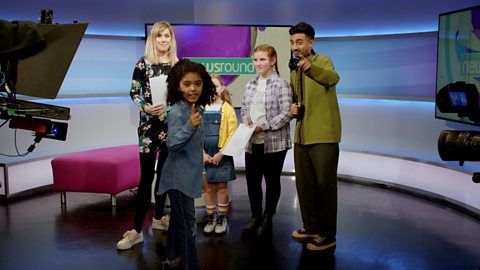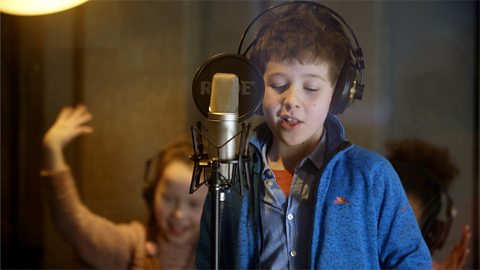Naomi: Hello! Guess where I am? Iãm on the set of a new teen drama called ãFlatmatesã.
Naomi: Lets go and have a look around!
Naomi: Right now, the team are very busy getting this set to get it ready for filming, but behind the scenes there is a whole other team all using their creative skills in different ways to achieve different things.
Naomi: Like the producer who will be organising all the filming schedules or getting all the cast and crew assembled,
Naomi: or the art director who will be putting the final touches onto all the props that will bring this set to life.
Naomi: Now of course none of this would be able to happen without scripts and on a production like this there is a whole team of script-writers and script editors and its their job to put down on paper a vision that the rest of the team will bring to life for you to watch.
Naomi: Can you imagine having an idea for a story in your head that will be transformed into a complete production by a huge team of people?
Naomi: I wonder how I would get started on something like that? Hereãs our script writing master to tell us more.
Naomi: Bronagh Taggart is one of the script writers on Flatmates, and has written for a whole range of children's programmes.
Bronagh: One of the golden rules for writing for television is the 'show don't tell' rule.
Bronagh: What that means is that its better to show something rather than to write lots of dialogue or lots of action.
Bronagh: For example, if you wanted to show that one of your characters was scared, instead of writing lots of dialogue you could actually show that with something as simple as 'their hands are shaking'.
Bronagh: Or if you wanted to explain that their had been a fight, instead of writing a long scene filled with lots of action you could just cut to someone with a black eye or an injury.
Bronagh: Your challenge is to write a scene for your own TV show and to try and use the 'show don't tell' rule.
Bronagh: Go get creative!
Naomi: Oh, nice challenge. I canãt wait to get started on this one!
Naomi: But Iãm going to need some help, I wonder who my helpers are?
Naomi: This is Lucy and her creative superpower is vocal acrobatics!
Naomi: Next we've got Rosa and she can pull out a performance any time, any place!
Naomi: And finally its Oliver, and he's got super-fast tapping feet!
Naomi: So what do you think of this challenge? You like it?
Oliver: Can we pick any programme we want?
Naomi: As long as it has recognisable characters that we can write lines for. So we'll choose a programme that we like, take two or three characters from that show and then we'll write a scene that they can feature in.
Naomi: Tell you what can help is choose a setting, something like a doctorãs waiting room, for example, and then it'll be our task to work out the story behind why they are there.
Rosa: So maybe like a shop or a grocery store?
Naomi: Thats a perfect idea! A grocery store would be great. I've got some scripts here that you can have a look at, see how they're laid outãÎ
Naomi: While you take a look at those, here are a few things you're going to need if you would like to take on this challenge.
Naomi: A pen or pencil,
Naomi: some paper,
Naomi: and some scripts to compare for layout.
Naomi: Right, so now we know what a script looks like itãs time to get some ideas down on paper.
Naomi: I am loving these ideas! The next step is to write our scenes. We're going to work together as a group but you can work alone if you prefer.
Naomi: Look for ways to show, not tell.
Naomi: Remember TV is all visual so you don't need to write long conversations or dialogue.
Naomi: Try to think about how the character would say something and not how you would say something.
Naomi: Well done team, we have totally nailed this! Excellent work! How about we try and act it out?
Naomi: Who's going to play what part?
Oliver: I'll be Timmy!
Rosa: I'll be Granny.
Lucy: And I'll be the Zookeeper.
Naomi: Does that mean I'm director? Perfect! Places please!
Oliver: Don't worry penguins, I'll set you free!
Naomi: He opens the gate and the penguins waddle out!
Rosa: Timmy, Timmy where are you? Its time to get lunch!
Naomi: A penguin waddles past Granny B and she pats it on the head.
Lucy: Why are you holding hands with a penguin?
Rosa: Its not a penguin, its Timmy!
Naomi: If you enjoyed this challenge there are loads more over on the ôÕÑ¿èÓ Teach website.
Naomi: You can design a chair, write a poem or produce a stop-motion animation!
Naomi: Go on, get creative!
Video summary
This short film presents a real-world context for writing a script and challenges children to write a short script for a TV show.
The presenter, Naomi Wilkinson, is on the set studio of a popular CôÕÑ¿èÓ show. A group of children are invited to take on the challenge of writing a short script for characters of their choice from the show.
Our ãMasterã scriptwriter will add to the challenge by inviting the children to use the ãshow donãt tellã rule, a golden rule of writing for the screen.
Using CôÕÑ¿èÓ scripts as a guide, the children write their own short scenes, which are shared at the end of the film. You can download scripts from Childrenãs television shows from the ôÕÑ¿èÓ Writersroom.
This short film is from the ôÕÑ¿èÓ series, Get Creative.
Teacher Notes
Before Watching
Talk to your pupils about their favourite TV shows. Ask them if they think there is anything different about writing a script to a story.
Share some of the scripts from the ôÕÑ¿èÓ Writersroom website or select some sections to show them.
You may want to create a class list of scriptwriting features to display as a reminder when children are writing.
After Watching
This activity can be done in groups, pairs or individually.
Give your pupils a few moments to pick the show and characters. Now, ask them to decide on a setting and scenario (i.e. where is this scene and what is the drama?)
The suggestions in the film are a doctors surgery or grocery store, but encourage children to be as creative as they like.
Allow them 10-15 minutes to write (cap the length of the scene to 1-2 pages, tops). You may want to display the Thinking Questions to help guide the writing.
As an extra challenge invite them to incorporate the ãMaster Skillã.
Master Skill
The words ãshow donãt tellã are used constantly in the writing world ã put simply it means think visually and allow visuals to show you what is happening and how characters are feeling, rather than you as a writer telling the reader/audience.
For example:Susan was very scared.
Is more powerful when you show that feeling, rather than tell it.
In a story you might write:Susan hesitated. Her breath quickened and her hand began to tremble.
In a script you would write this as action.Susan hesitates. Her breath quickens and her hand begins to tremble.
Or you might include it as dialogue/action.
Rather than:Susan: Iãm scared.
It would be more interesting to write:
Susan: (whispering) I donãt think we should go in thereãÎ we donãt know what we might find.
Discuss the concept of making your scripts more interesting and powerful by ãshowing not tellingã and having the characters put across their thoughts/feelings without outwardly saying them.
You may want to model this with examples as above.
Thinking Questions
- Who is in my scene?
- Where is my scene?
- How do the characters talk and interact with each other?
- Where is the conflict or drama in my scene?
- What are my characters thinking and feeling and how can I show this through their dialogue (without them saying outright)?
Supported Learning and SEN
The complexities of script-writing could be a lot for children who struggle with the written word to take on, however drama and spoken word can be a lot of fun and freeing for these children too. And thinking in terms of the visuals of a television show may appeal to those not usually enthused by written material.
There are many ways you could make this challenge more accessible for children, here are a few ideas:
- Have children improvise the scenes in pairs/groups first.
- Allow an adult or more abled peer to scribe for the group.
- Consider recording the improvised scenes on a tablet, as a reminder for when they come to write, or as a way of taking writing out altogether.
- Create a template with script layout and names already included.
- Create a support sheet with spellings of names, difficult words.
Extend this Activity
- Perform the scenes in a live showcase for parents/assembly/another class or just each other.
- Film the scenes and make short movies ã you could upload these to the school website.
- Use the scenes to create another piece of writing ã a short story, a news report.
- Write a ãHow to Write A Scriptã fact sheet, that can be kept for future reference or shared with other classes, or the school website.
Curriculum Notes
This short film is designed to support the teaching of creative writing for KS2 in England, Wales, Northern Ireland and for 2nd level in Scotland.
In England the video offers pupils a chance to write with purpose in context, using the skills of notation and editing whilst also providing the opportunity to read work aloud and work towards mastery through developing specific key skills.
In Wales the video provides an opportunity for pupils to write creatively with chances to adapt their writing for purpose, use a range of language skills, note ideas and plan their writing then reflect, redraft and improve their work.
In Northern Ireland the video gives pupils the opportunity to participate in independent or group writing, select, plan and adapt their writing for purpose, express thoughts and feelings through their imaginative compositions, experiment with language and practise the skills of revising and redrafting their compositions.
In Scotland the video presents pupils with an example of contextual writing to explore, from which they can create their own pieces of writing from notes, use appropriate vocabulary, language and style to engage their reader and check their writing for sense and purpose.
This short film will help children to:
- Participate in shared and independent creative writing.
- Analyse the features of a specific writing style (scripts) and create their own.
- Adapt writing to suit a purpose.
- Use dialogue to convey character and further plot.
Write a poem. video
In this short film for primary schools, Naomi Wilkinson and a group of children are challenged to write a poem for someone they know.

Create a story. video
A visit to the Newsround studio presents real-life context for telling a story and a challenge for children to tell a story as a short news report.

Write song lyrics. video
Karim Zeroual and a group of children take on the challenge of writing their own song lyrics.
